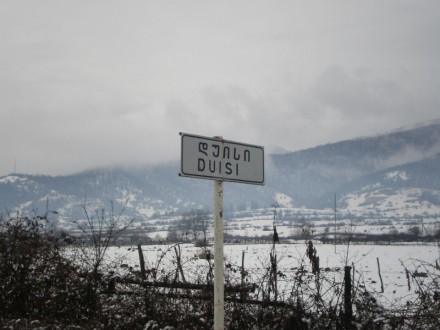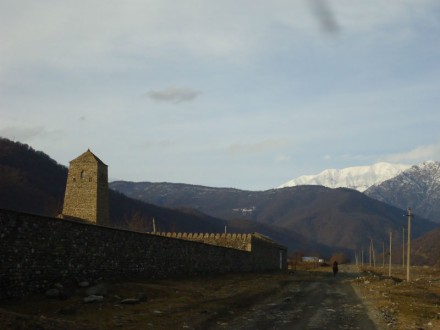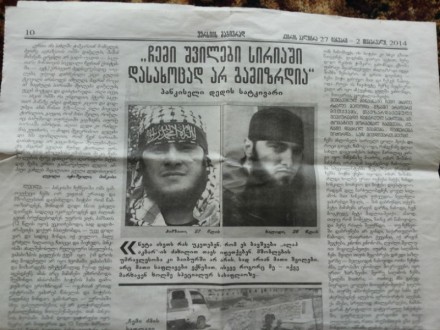
Duisi, DFWatch – Counterextremism efforts in the Pankisi Valley fall short as they fail to address root causes of radicalisation processes in the region.
Following the reporting on Georgian citizens leaving the country to join the ranks of foreign fighters in the civil war in Syria and Iraq, the question of religious radicalisation in the Pankisi Valley has become one of the most debated security issues in Georgia.
The valley located in the Akhmeta municipality of Kakheti region is home to some 8,000 people, the majority of which identify as Kists, Chechens, or both. A local dialect of Chechen is the first language for virtually all inhabitants of the valley, while Georgian is the official language of schools and state institutions. Russian is also widely understood except among some older members of the community.
It is difficult to estimate the exact number of people who left Pankisi for Syria. While Turkey is a transit country for many fighters-to-be, many Kists travel there in search of employment and choose to stay there indefinitely. Local inhabitants often give the number of 25 fighters as an estimate, although the number of 200 has also been mentioned in media reports.
Different factors were suggested as contributing to the decision made by young people to travel abroad in order to join the jihadi movement. The ‘radicalisation’ has been variously described as a security challenge to the Georgian state and a problem per se. On the contrary, it seems that embracement of a violent ideology is a symptom of a variety of unaddressed root issues that have plagued the population of the valley for years — combined with other factors specific to the region and the community.
Economic factor
‘If the state doesn’t find something for the young people to do, with time they might find the idea of travelling to Syria attractive’, one inhabitant of Pankisi told DF Watch.
With the soaring unemployment of 90%, the lack of possibilities for young people is the issue most often brought up in informal conversation with inhabitants of the valley.
Tbilisi, Western Europe, Turkey, Moscow, or Grozny are common destination for young families disillusioned with the economic prospects in the valley and the scarcity of options for personal development.
‘I dreamt of becoming a policeman, but the only career path available for me was in intelligence services based in Pankisi’, a young man who recently moved to Chechnya says. ‘I didn’t want to spy on my own community, which made it impossible for me to pursue this path’.
The traditional ways of life involving agriculture and pastoralism have been disrupted by the heavy economic crisis that hit Georgia following the dissolution of the Soviet Union as well as by the humanitarian crisis caused by the influx of refugees from Chechnya in the 1990s and early 2000s.
Although the economic situation in the valley remains dire, the economic factor alone provides an insufficient framework to provide an explanation as for why certain young people embrace violent ideologies.
Religious factor

The appearance of new forms of religious expression in the valley is a common shorthand explanation and a synonym for ‘radicalisation’ and ‘extremism’.
Kists traditionally subscribed to a Sufi branch of Sunni Islam that emphasises the personal experience of communion with God by means of worship that include group invocations of chants (dhikr). Islam in Pankisi was very local, deeply embedded in Chechen traditions and ways of conduct (adat).
Nowadays, the majority of Kists subscribe to a Salafi branch of Islam that emphasises purity in doctrine and a strict adherence to the Islamic law (sharia) stemming directly from the Quran.
Salafi Muslims are commonly known as ‘Wahhabis’ throughout the valley, although this term is considered misleading and derogatory by some adherents.
Salafi jihadism is a tiny yet infamous branch of the movement. Its ideology is heavily politicised and advocates use of violence against ‘enemies of Islam’.
‘Ten years ago, all mosques were for the most part Sufi with small compartments reserved for Salafis. Nowadays, it’s the opposite’, one man tells DF Watch.
The shift in religious practice can be associated with two factors.
Firstly, Salafism gained ground among many Kists following the influx of refugees from Chechnya. The two wars in Chechnya constituted a generational experience for Pankisi’s youth, which stimulated their identification with the wider Chechen nation. Endorsement of the Chechen independentist cause made Chechen fighters attractive role models for youth striving to find their identity in newly independent Georgia which was at the time heavily influenced by extreme nationalist ideologies. By proxy, many young people found the religious practices of Chechen fighters models to follow.
Secondly, the spread of internet access in Pankisi and new technologies further delocalised religious identifications by detaching them from their local context and placing them in the realm of the global. Nowadays, a young person doesn’t necessarily look towards their local mosque for religious instruction; everyone can easily engage with global religious trends by reading literature or listening to sermons online.
The access to new technologies partially explains the generation gap between elderly Kists who tend to follow old traditions, including music and dance, and young people who reject them as un-Islamic. These young people often identify closer with the global Muslim community (umma) than the local community of Pankisi Muslims.
Needless to say, every young person is free to engage with extremist materials online, including the ones published by groups such as the Islamic State. By doing so, they render heavily localised counterextremism efforts insufficient or even misguided.
Political factor

The Chechen national awakening connected Kists to the political trends and discourses present in the Chechen society, with all its internal conflicts and divisions.
As Grozny TV appears to be the most watched TV channel in Pankisi’s households, the botched effort of creation of a pan-Georgian identity and integration of Kists into the Georgian society resulted in a situation where many Kists choose to look towards Chechnya as a source of identification.
One can find Kists who support the defunct project of the Chechen Republic of Ichkeria, the ruthless rule of Ramzan Kadyrov, or the Islamist insurgency in the North Caucasus.
The religious factor alone is insufficient to explain the attractiveness of the jihadi ideology among some members of the community. After all, the destination is very specific; Kist fighters don’t choose to travel to, let’s say, Afghanistan to fight NATO forces, or to Nigeria to join Boko Haram. Predominantly Christian Georgia isn’t a target of their violence either.
The Kist jihadism is heavily influenced by political factors that have roots in the Chechen nationalist — and originally secular — project that was thwarted by the Russian Federation by violent means. There is anecdotal evidence of Kists who used to travel to the North Caucasus in order to join the insurgency; although its ideology is now deeply Islamist, it has always had its centre of gravity in the anticolonialist project of independence of Chechnya and other North Caucasian republics from Russia.
As it is now virtually impossible to conduct a meaningful fight on the Russian territory, many Chechens choose to join ranks of groups who fight forces which are directly or indirectly supported by Russia: the breakaway republics in Eastern Ukraine (nationalists) and Syrian governmental forces (jihadis).
The importance of Russia as the transposed object of armed violence is visible in the recent stir in social networks regarding the Russian direct military involvement in the Syrian civil war. The Islamic State and the al-Nusra Front have already called ‘Islamic youth everywhere’ to engage in holy war against Russia. For many, a chance to confront Russia directly is a dream come true and it is very likely that it will attract more Kists into joining the jihadi movement.
Gender factor
Although it is usually men who engage in direct violence informed by religious and political ideologies, it is important not to overlook the role of women and wider gender dynamics in the radicalisation process.
Focus on men’s explicit manifestations of extremism obscures the fact that many women also embrace the jihadi ideology and make conscious decisions to travel to territories controlled by extremist groups.
Radical political ideologies such as fascism, neo-Nazism, or jihadism usually embrace sexist and homophobic ideas with a clear-cut separation of gender roles which are perpetuated both by men and women.
As traditional gender roles practiced in the Pankisi valley have been corroded by a new local setting as well as the influence of both Western and Islamist ideas, many young people increasingly confirm their male and female identities in an Islamist framework.
The extremely defined gender roles with the men’s control over women’s fertility, sexuality, education, and economic activity underpin the gendered model of jihadism in which men’s obligation is to fight, while women’s obligation is to raise the future generations of fighters.
A closer study of changes in gender dynamics in the Pankisi valley can produce valuable insights into the complex interplay or religious, political, and cultural factors that contribute to the embracement of violent ideologies.
Institutional factor
There is a mixed record of certain Georgian institutions when it comes to tackling radicalisation-related issues in the Pankisi Valley.
For a variety of historical reasons, the Georgian Orthodox Church has traditionally been seen as the stronghold of Georgian national identity. An unnuanced view advanced by the Church in which being Georgian equals being Orthodox has hindered integration efforts of numerous minorities into the Georgian society and fuelled the antagonism between Georgia’s Christian and Muslim communities.
The dominance of the Georgian Orthodox Church and the lack of inclusivity makes a number of Kists question their place in the Georgian society.
The Georgian government doesn’t seem to have a strategy regarding the variety of structural factors contributing to radicalisation either.
According to EurasiaNet, the Georgian government planned to host in Pankisi a training camp for anti–Islamic State fighters functioning as a ‘counterterrorism training centre for any nationality’. Although the Georgian State Security and Crisis Management Council later denied such plans without specifying reasons, such an initiative would only be cosmetic in its treatment of symptoms of the issue rather than its root causes.
In an anonymous conversation with DF Watch one inhabitant of the valley said that the region is heavily penetrated by the Georgian Intelligence Service, yet the efforts at disrupting the local network of recruitment of fighters are minimal. He described the recent arrest of suspected Islamic State recruiter Ayyub (Gaioz) Borchashvili as only ‘the tip of an iceberg’. In his piece for The Intercept, journalist Marcin Mamoń suggests that the Georgian Intelligence Service wants to keep its contact with Islamic fighters alive. He recalls the case of Georgian journalist Gela Mtivlishvili who presented evidence of recruitment to the Georgian Counterterrorism Centre of the Ministry of Internal Affairs — to no avail.
DF Watch reported earlier this year that there is a demand among inhabitants of the valley for classes in moderate Islam taught in public schools. Currently religious education is available only through a religious school located next to the Salafi mosque in Duisi.
The Georgian government adopted amendments to the country’s Criminal Code that set tougher punishments for those found guilty of participating in illegal armed groups abroad or of recruiting others to do the same. In an interview for Radio Free Europe/Radio Liberty, analyst Michael H. Cecire noticed that ‘[t]here is no good evidence that tailored legal codes will help ameliorate the foreign-fighter issue in Georgia. The experience elsewhere — in nearby Azerbaijan, for example — shows that such laws may lend the appearance of government action but do little to actually arrest the flow of foreign fighters and sympathetic noncombatants to Syria or Iraq’.
Ways forward
The Georgian government has potential and legitimacy to step up on it efforts at addressing the variety of structural factors that contribute to radicalisation processes in the Pankisi Valley. As these factors engage with each other in a complex interplay, development of a nuanced and comprehensive approach should take precedence over legal frameworks and ad hoc security means.
A combination of a just and sustainable economic development together with a strengthening of local religious and cultural institutions could provide a positive framework for personal advancement for young Kist men and women in the Georgian society.
At the same time, it could be beneficial to challenge extremist narratives by opening them up for debate in a neutral setting. Educational measures should give young people tools to critically dissect violent narratives and reflect on propaganda mechanisms encountered in media and online sources.
Finally, all efforts should include a careful approach towards local gender dynamics in order to develop a culturally and religiously sensitive way of combatting sexism and homophobia.
The ongoing violence in the North Caucasus, with its own multitude of root causes embedded in Russian federal and local institutions is likely to continue being a negative factor which the Georgian government has virtually no capacity to address. These root causes include the unsustainable model of development which produces grave social injustices, rampant corruption, extrajudicial killings of suspected fighters, religious prosecution, political prosecution, and reactionary gender identity politics — only to name a few.
The local Islamic extremism will also continue to be influenced by global North–South and centre–periphery tensions, inequalities, and the myriad of unaddressed issues in the (post)colonial Middle East.
After a deeper examination it becomes clear that ‘radicalisation’ is only the top of the iceberg among the array of issues faced daily and solitarily, locally and globally by inhabitants of the Pankisi Gorge.

